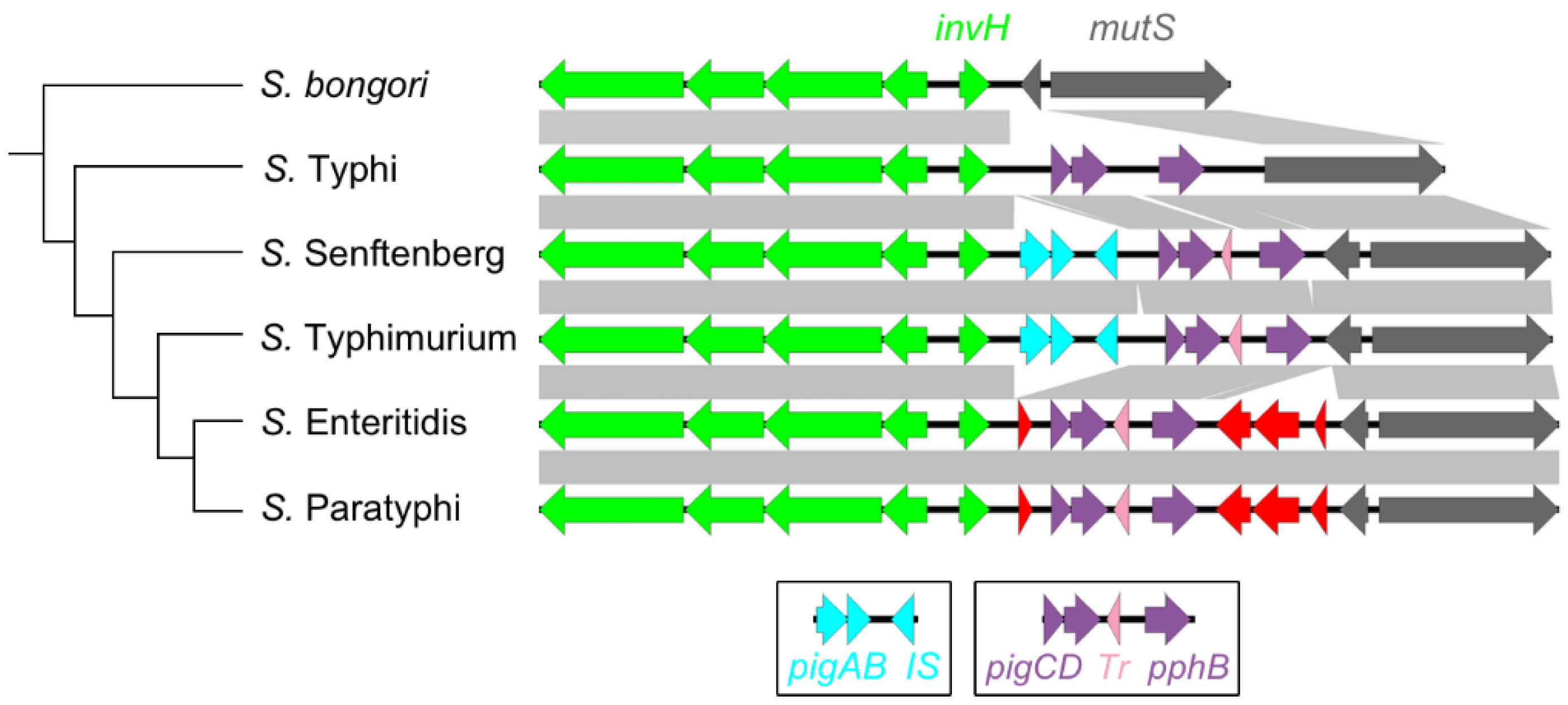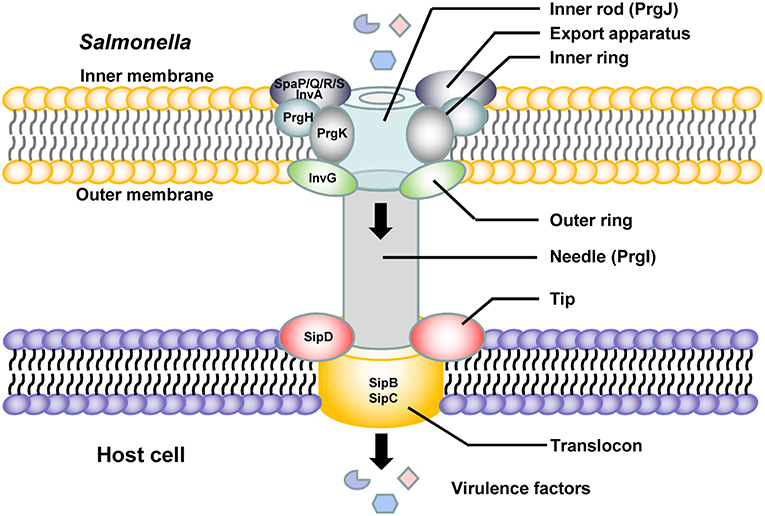Induction of Salmonella pathogenicity island 1 under different growth conditions can affect Salmonella-host cell interactions in vitro. Constituye un grupo importante de patógenos para animales y personas.

Schematic Representation Of Salmonella Pathogenicity Island 19 In S Download Scientific Diagram

The Salmonella Pathogenicity Island 1 Type Iii Secretion System Sciencedirect

Schematic Representation Of Salmonella Pathogenicity Island 19 In S Download Scientific Diagram
Finally the SPI-5 island encodes for factors involved in the fluid secretion and inflammatory reaction in.

Salmonella pathogenicity island. The SPI-2 and SPI-3 islands control the intracellular survival and replication. 1 74 Pathogenicity islands consist of large regions of genomic DNA approximately 10200 kilobases that are present in. Salmonella de nombre común salmonela 1 es un género bacteriano perteneciente a la familia Enterobacteriaceae constituido por bacilos gramnegativo intracelulares anaerobios facultativos con flagelos peritricos.
Once the bacteria have reached sufficient numbers in the gut by outcompeting the gut flora they utilize their first T3SS to facilitate entry into the M cells. Pneumophila invasion of macrophages and its working. Failed verification The ones that do are collectively known as enterohemorrhagic E.
View Record in Scopus Google Scholar. The P fimbriae island contains virulence factors such as haemolysin pili cytotoxic necrosing factor and uropathogenic specific protein USP. An example of such analysis can be seen in Figure 3A where the translated nucleotide sequences from genes encoded by the Locus of Enterocyte Effacement LEE pathogenicity island in the Enterohaemorrhagic E.
Bongori de las cuales la S. Coli VTEC are strains of the bacterium Escherichia coli that produce either Shiga toxin or Shiga-like toxin verotoxin. Jermyn WS Boyd EF.
Typhi have Salmonella pathogenicity islands SPIs that contain the genes for many of their virulence factors. Está compuesto por dos especies. Genetic exchange in Salmonella.
Legionella pneumophila is an intracellular pathogen that can cause Legionnaires disease by invading alveolar epithelial cells and macrophages. Coli EHEC and are major causes of foodborne. Several Salmonella pathogenicity islands have been identified that mediate uptake of the bacteria into epithelial cells type III secretion system TTSS nonphagocytic cell invasion Salmonella pathogenicity-island 1 SPI-1 and survival and replication within macrophages Salmonella pathogenicity-island 2 SPI-2 phoPphoQ.
Members of the genus Salmonella cause a well-characterized spectrum of disease in humans ranging from asymptomatic carriage to fatal typhoidal fever. Salmonella pathogenicity island 2-dependent evasion of the phagocyte NADPH oxidase. Salmonella Typhimurium induces a rapid and time-dependent LD biogenesis in murine macrophages.
Salmonella enterica is a Gram-negative food-borne pathogen that causes human diseases ranging from mild gastroenteritis to severe systemic infections. Coli strain O157H7 Sakai genome were compared to the translated nucleotide sequence of whole genomes of other published Enterohaemorrhagic E. Salmonella SP1 and SP2 sites.
Only a minority of the strains cause illness in humans. Evidence that salmonella pathogenicity island 1 has alternative functions during infection. In the intestines Salmonella evade host defense mechanisms by entering epithelial cells using proteins encoded by Salmonella pathogenicity island 1 SPI1 212223.
Pathogenicity islands were first described in pathogenic species of E coli but have since been found in the genomes of numerous bacterial pathogens of humans animals and plants Salmonella Vibrio Shigella Yersinia Listeria S aureus etc. Invasion genes are not required for Salmonella enterica serovar typhimurium to breach the intestinal epithelium. Yersinia pestis high pathogenicity island I has genes regulating iron uptake and storage.
The major outer membrane protein MOMP plays an important role in the interaction between bacteria and host cells. For an infection to occur the intracellular growth of Salmonella in macrophages is crucial. Proc Natl Acad Sci U S A.
A Vibrio cholerae pathogenicity island associated with epidemic and pandemic strains. Upon successful crossing of the intestinal epithelial barrier Salmonella serovars invade the underlying lymphoid tissues and subsequently get endocytosed by host macrophages 214. Pathogenicity island 1 SPI-1.
The LD formation depends on Salmonella viability and SPI1-related T3SS activityTLR2 and TLR4 signaling exhibit opposite roles in LD formation and bacterial infection control in murine macrophagesThe inhibition of lipid remodeling by DGAT-1 and cPLA2. Two examples of important typhoid toxins are the Vi antigen which encodes for capsule production and chimeric A2B5 toxin which causes many of the signs and symptoms of the acute phase of typhoid fever. Can hijack helper phages for high-efficiency transduction of the island.
Science 287 2000 pp. Links 58. The SPI-4 island encodes a putative type I secretion system and its believed that it participates in the intracellular survival.
This cellular invasion has not. The bacteria are located in a special membrane compartment the so-called Salmonella-containing vacuole SCV. Salmonella serovars can also use macrophages and dendritic cells as a vehicles for systemic dissemination of infection by using Salmonella pathogenicity island SPI T3SS-2 212213.
However the role of MOMP in the process of L. The synthesis and transportation proteins of the Vi capsular polysaccharide of Salmonella enterica serovar Typhi serovar Typhi are encoded by the viaB operon which resides on a 134-kb pathogenicity island known as SPI-7. Ibarra JA Knodler LA Sturdevant DE Virtaneva K Carmody AB Fischer ER et al.
Shigatoxigenic Escherichia coli STEC and verotoxigenic E. To invade and disseminate Salmonella makes use of Type-III secretion systems T3SS encoded on two pathogenicity islands hereafter SPI-1 and SPI-2 which serve different functions. Characterization of a novel Vibrio pathogenicity island VPI-2 encoding neuraminidase nanH among toxigenic Vibrio cholerae isolates.
In the developed world food-borne acute gastroenteritis and enterocolitis are the most common forms of Salmonella infection with an estimated 12 million annual cases of non-typhoidal. Illuminating the landscape of host-pathogen interactions with the bacterium Listeria monocytogenes. Bacterial pathogenicity and evolution.
Plos Biology Adding Function To The Genome Of African Salmonella Typhimurium St313 Strain D23580

Microorganisms Free Full Text Salmonella Pathogenicity Island 1 Spi 1 The Evolution And Stabilization Of A Core Genomic Type Three Secretion System Html

Frontiers Salmonella Pathogenicity Island 1 Spi 1 And Its Complex Regulatory Network Cellular And Infection Microbiology

Quantitative Mass Spectrometry Catalogues Salmonella Pathogenicity Island 2 Effectors And Identifies Their Cognate Host Binding Partners Journal Of Biological Chemistry

The Salmonella Pathogenicity Island Spi 1 Contributes More Than Spi2 To The Colonization Of The Chicken By Salmonella Enterica Serovar Typhimurium Bmc Microbiology Full Text
Plos One Crosstalk Between Virulence Loci Regulation Of Salmonella Enterica Pathogenicity Island 1 Spi 1 By Products Of The Std Fimbrial Operon
Pathogenicity Island Excision During An Infection By Salmonella Enterica Serovar Enteritidis Is Required For Crossing The Intestinal Epithelial Barrier In Mice To Cause Systemic Infection
What Does Spi1 Mean Definition Of Spi1 Spi1 Stands For Salmonella Pathogenicity Island 1 By Acronymsandslang Com
